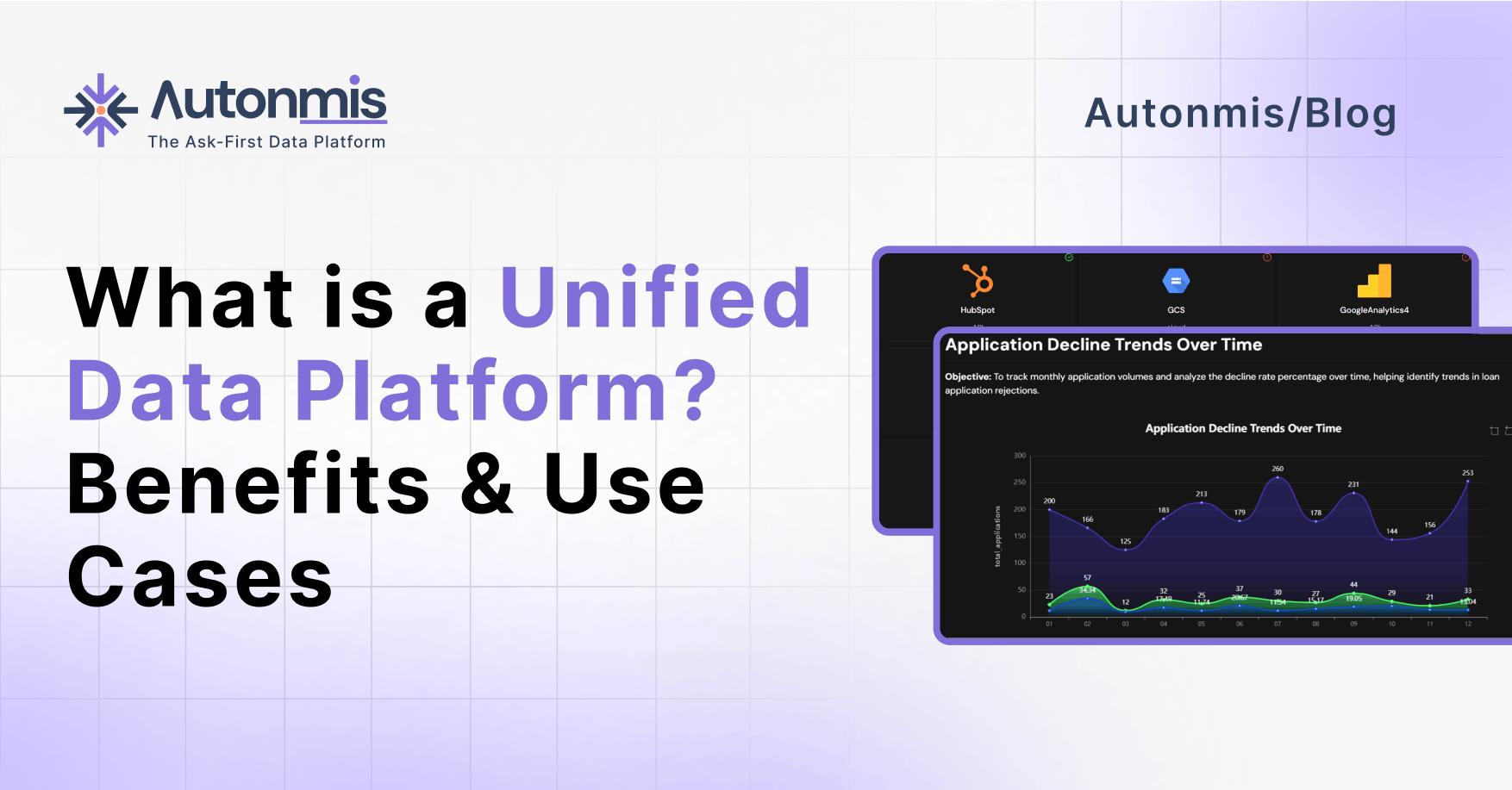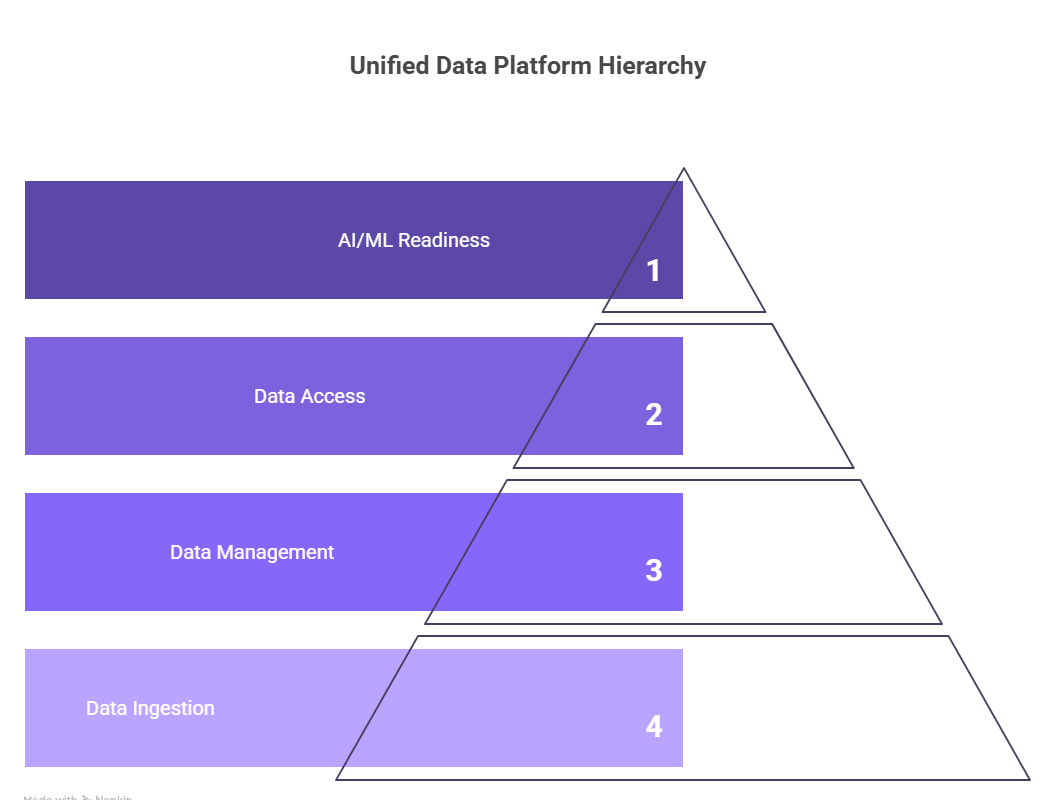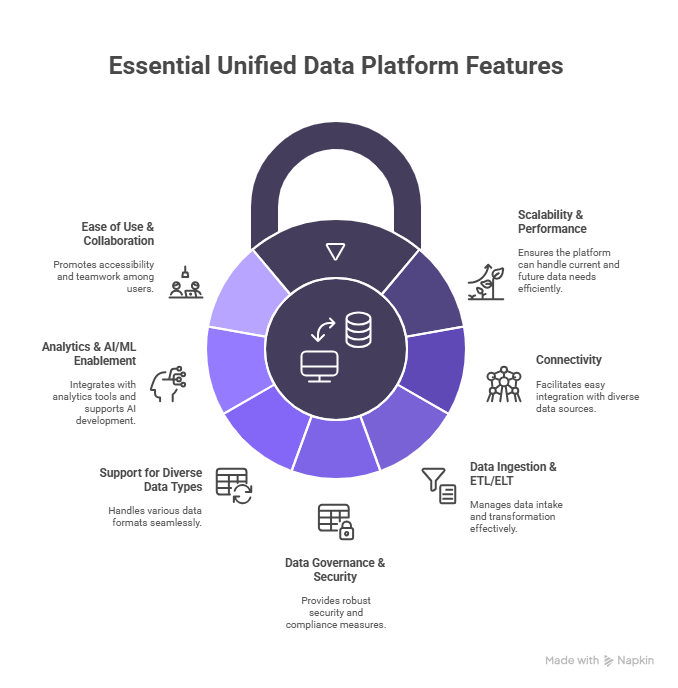Table of Contents
Loading table of contents...
What is a Unified Data Platform and Why Do Businesses Need One?
A Unified Data Platform (UDP) centralizes every data source—CRM, ERP, logs, IoT, marketing—into one trusted environment, breaking down silos and delivering a single source of truth. It streamlines the entire data lifecycle (ingest → store → transform → govern → analyze), powers AI/ML with ready-to-use datasets, and embeds governance and security throughout. By unifying pipelines, dashboards, and AI-driven insights, organizations can make faster, data-driven decisions, reduce costs, and unlock new innovation.
May 23, 2025

AB

You’ve got data—mountains of it. Customer data, transactional data, operational data, IoT data, marketing data … it’s flowing in from every conceivable direction. But:
Is it working for you?
Or does it feel more like a raw torrent, where locating a single, trustworthy insight is like searching for a needle in a haystack?
If you’re nodding along, you’re not alone. Even the savviest teams often struggle to turn vast data assets into real business value. The culprit? A fragmented, siloed landscape. Enter the Unified Data Platform (UDP)—not just another tool, but a foundational shift in how you manage and leverage your most critical asset: data.
As senior data professionals, executives, and product leaders, you understand the strategic imperative of data. Let's explore what a Unified Data Platform truly is and why it's rapidly becoming indispensable for businesses aiming to thrive in the AI-driven era.
What Is a Unified Data Platform?
More Than “Just a Better Database”
A UDP is an integrated, intelligent fabric that centralizes all your data sources—CRM, ERP, marketing tools, logs, sensors—into one trusted environment. Think of it as the water-treatment-and-distribution system for your raw data:
- Single Source of Truth
Harmonizes and syncs data so every team sees the same, up-to-date picture. - Full Lifecycle Management
From ingestion → storage → transformation → governance → analysis, all in one place. - Democratized Access
Secure, role-based access for analysts, data scientists, and business users alike. - AI/ML Ready
Clean, curated data “fuel” to drive predictive models, recommendations, anomaly detection, and more.
Analogy:
If your data sources are individual wells, a UDP is the purification plant and pipeline network that delivers reliable “insights on tap” to every department.

Why Your Business Can't Afford to Ignore Unified Data Platforms
The shift towards Unified Data Platforms in businesses isn't just a trend; it's a response to pressing needs and the ever-increasing complexity of the data landscape. Here’s why forward-thinking businesses are making the move:
- Obliterating Data Silos for a 360-Degree View:
- The Problem: Siloed data leads to a fragmented understanding of your customers, operations, and market. Marketing might have one view of a customer, sales another, and support yet another. This inconsistency cripples effective decision-making and personalized experiences.
- The UDP Solution: By integrating data across departments and systems, you gain a true 360-degree view. Imagine understanding the complete customer journey, from initial contact to post-purchase behavior, all in one place. This enables unprecedented levels of personalization and proactive service.
A report by McKinsey highlights that companies leveraging integrated data for a 360-degree customer view can achieve significant improvements in customer satisfaction and revenue growth
- Fueling Accurate and Agile Decision-Making:
- The Problem: When data is scattered and untrustworthy, decisions are often based on gut feelings, outdated information, or painstaking manual reconciliation efforts. This is slow, inefficient, and risky.
- The UDP Solution: With a reliable, unified source of data, business leaders and teams can access timely, accurate insights. This accelerates the decision-making process and instills confidence that choices are data-driven.
- Example: A retail company can use a UDP to analyze real-time sales data, inventory levels, and marketing campaign performance simultaneously to make rapid adjustments to pricing or promotions.
Research by Forrester indicates that data-driven organizations are 2.5 times more likely to report superior financial performance
- Unlocking the True Potential of AI and Machine Learning:
- The Problem: AI/ML models are only as good as the data they're trained on. Data scientists often spend up to 80% of their time finding, cleaning, and preparing data rather than building models. Fragmented, poor-quality data is a major bottleneck for AI adoption.
- The UDP Solution: A UDP provides a curated, governed, and easily accessible repository of data that's ready for AI/ML applications. This significantly reduces data preparation time, improves model accuracy, and accelerates the deployment of AI-powered solutions – from predictive maintenance to fraud detection and personalized recommendations.
- As noted by industry analysts, organizations with mature data strategies, often underpinned by unified platforms, see significantly higher ROI on their AI investments.
- Enhancing Operational Efficiency and Reducing Costs:
- The Problem: Managing multiple, disparate data systems is complex and expensive. It requires specialized skills for each system, leads to redundant data storage, and increases the overhead of data integration and maintenance.
- The UDP Solution: By consolidating data infrastructure, a UDP can streamline operations, reduce the need for numerous point solutions, and lower overall data management costs. Automation capabilities within UDPs further enhance efficiency.
According to Gartner, organizations can reduce data management costs by up to 30% by adopting a unified data platform approach.
- Strengthening Data Governance, Security, and Compliance:
- The Problem: In a siloed environment, enforcing consistent data governance policies, ensuring robust security, and meeting compliance mandates (like GDPR, CCPA, HIPAA) is a nightmare. Tracking data lineage and managing access controls across multiple systems is incredibly challenging.
- The UDP Solution: A centralized platform allows for the consistent application of governance rules, access controls, and security protocols across all your data. This simplifies compliance reporting, enhances data security, and builds trust with your customers and stakeholders.
- Driving Innovation and Competitive Advantage:
- The Problem: Without easy access to integrated, reliable data, it's difficult to spot emerging trends, identify new market opportunities, or rapidly prototype innovative products and services.
- The UDP Solution: A UDP empowers teams to explore data freely, experiment with new ideas, and derive insights that can lead to product innovation, improved customer experiences, and ultimately, a stronger competitive edge.
Studies show that 66% of executives are leveraging data to foster innovation, indicating a clear link between data strategy and competitive advantage
Checkout: What is an AI Data Platform and How Does It Work?
Key Characteristics to Look For in a Unified Data Platform
Not all platforms labeled "unified" are created equal. As you evaluate options, consider these key characteristics, especially if you're looking to build a robust foundation for AI:
- Scalability & Performance: Can it handle your current and future data volumes and processing needs?
- Connectivity: Does it offer pre-built connectors or easy integration capabilities for a wide range of data sources (databases, cloud storage, SaaS apps, streaming data)?
- Data Ingestion & ETL/ELT Capabilities: How does it handle data ingestion from various sources? Does it provide robust transformation capabilities?
- Data Governance & Security Features: Look for fine-grained access control, data lineage, auditing, encryption, and support for regulatory compliance.
- Support for Diverse Data Types: Can it handle structured, semi-structured, and unstructured data?
- Analytics & AI/ML Enablement: Does it integrate with popular analytics tools and provide an environment conducive to developing and deploying AI/ML models? Consider features like model management and experiment tracking.
- Ease of Use & Collaboration: Is the platform accessible to different user personas (data engineers, analysts, scientists) and does it foster collaboration?

Is a Unified Data Platform Right for Your Business? The Litmus Test
If you're experiencing any of the following, it’s a strong indicator that a unified data platform should be high on your strategic agenda:
- You struggle to get a consistent view of your customers or operations.
- Your teams spend more time searching for and preparing data than analyzing it.
- Your AI/ML initiatives are stalled or underperforming due to data challenges.
- Decision-making is slow, and you lack confidence in your data.
- Maintaining data compliance and security across disparate systems is a growing burden.
- You feel you're missing out on opportunities because you can't leverage your data effectively.
The Journey Towards Unified Data: It's a Strategic Imperative
Implementing a Unified Data Platform is more than an IT project; it's a strategic business initiative. It requires a clear vision, executive sponsorship, and a phased approach. But the rewards – enhanced agility, deeper insights, accelerated innovation, and a true data-driven culture – are substantial.
In today's competitive landscape, and with the transformative potential of AI on the horizon, organizations that can effectively unify and activate their data will be the ones to lead. The question is no longer if you need a Unified Data Platform for business, but how quickly can you embrace one to unlock the full power of your data assets.
Ready to stop drowning in data and start driving real business value? It might be time to explore how a Unified Data Platform can be your organization's lifeline.
With Autonmis, you can finally collapse data silos into a single, conversational workspace—no more juggling ETL scripts, BI tools, and specialist teams. In under four days, spin up reliable pipelines, dashboards, and AI-powered insights simply by asking questions—freeing your analysts to act on trusted data instantly while cutting total cost of ownership by up to 60%.
Autonmis brings your entire data lifecycle into a single, conversational workspace:
- Explorer Edition helps small teams set up self-service pipelines and basic dashboards in minutes.
- Workspace Edition adds governance, collaboration features, and compliance controls for growing organizations.
- Conversational Enterprise scales AI-driven analytics across large teams with enterprise security and around-the-clock support.
Under the hood, the Autonmis Notebook unifies SQL, Python, and AI; pipelines move seamlessly from development to production; and real-time AI insights power your dashboards
Recommended Blogs

10/17/2025

AB
How GFF 2025 Changes the Way BFSI Will Operate in India

10/13/2025

AB
Top 5 Ways to Improve Lending Operations for Business Growth
Actionable Operational Excellence
Autonmis helps modern teams own their entire operations and data workflow — fast, simple, and cost-effective.